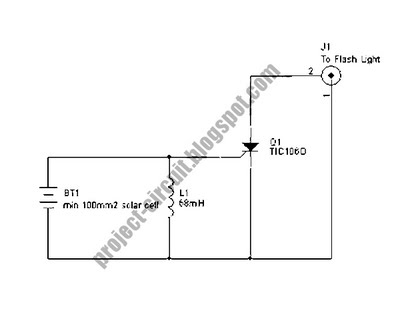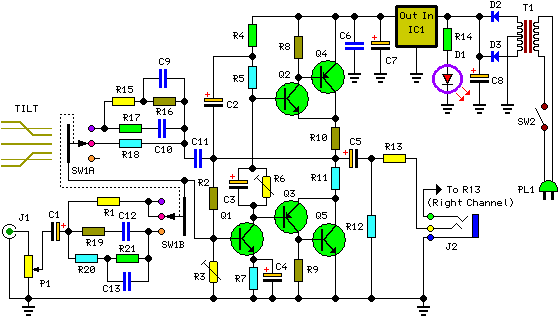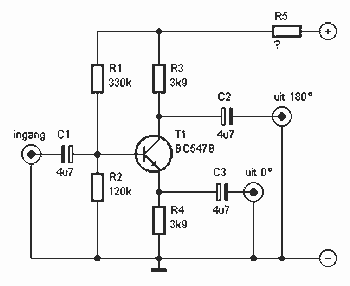
Light Sensor Circuit Using Op Amp 741

This is a light sensor circuit designed to detect darkness, utilizing the op-amp 741 integrated circuit as the primary control element. The circuit is straightforward and specifically designed to sense light during nighttime. The light detection is accomplished using a Light Dependent Resistor (LDR). Under normal lighting conditions, the LDR exhibits high resistance, resulting in pin 2 of the op-amp being low. When light strikes the LDR, its resistance decreases to a few hundred ohms, causing pin 2 to go high. This change biases the base of transistor Q1 through pin 6 and resistor R4, subsequently activating the relay. A trimmer potentiometer (P1) along with two 470-ohm resistors (R2 and R3) forms a voltage divider to adjust the sensitivity of the circuit. To reverse the action of the sensor to detect darkness instead of light, the positions of the LDR and resistor R1 should be swapped. If the relay exhibits chattering, a hysteresis effect can be introduced by adding a resistor (R6) ranging from 100K to 1M ohms across pins 6 and 2 of the op-amp; typically, a value between 100K and 330K is sufficient. The LDR used is a standard, general-purpose type. Diode D1 functions as a spark arrestor when the relay contacts open. The power supply for this circuit operates at 12 V DC.
The light sensor circuit operates effectively by leveraging the characteristics of the LDR and the op-amp. The LDR's resistance varies inversely with the intensity of light; as light levels drop, the resistance increases, which is critical for the functioning of this circuit. The op-amp 741 is configured in a comparator mode where it compares the voltage at pin 2 (connected to the LDR) with a reference voltage at pin 3. When the voltage at pin 2 exceeds the reference voltage, the output at pin 6 goes high, turning on the transistor Q1, which in turn activates the relay.
The inclusion of the trimmer potentiometer P1 allows for fine-tuning of the sensitivity, making it adaptable to different ambient light conditions. The use of resistors R2 and R3 in conjunction with P1 ensures that the voltage divider can be adjusted to set the threshold at which the sensor activates.
For applications requiring the reverse functionality—detecting darkness instead of light—the simple modification of swapping the LDR and resistor R1 allows for this. This flexibility makes the circuit versatile for various use cases, such as automatic streetlights or security lighting.
The addition of resistor R6 introduces hysteresis, which is essential in preventing the relay from rapidly switching on and off due to minor fluctuations in light levels. This is particularly useful in environments where light conditions may vary frequently, such as near streetlights or during twilight.
Diode D1 is crucial for protecting the circuit from voltage spikes generated when the relay contacts open, ensuring the longevity and reliability of the circuit components. The overall design operates on a 12 V DC power supply, making it suitable for integration into various electronic systems requiring low-voltage operation.This is a one of the light sensor. This circuit is a dark sensor that is based on op amp 741 IC as main control. This circuit is a simple design for sensor the light at the night. This is the figure of the circuit. For sensor the light is using LDR. Operation of the circuit is under normal conditions the resistance of the LDR is high, keeping pin 2 low. When light falls onto the LDR the resistance drops to a couple hundred ohms and triggers pin 2 high which biases the base of Q1 via pin 6 and R4 and in turn activates the relay. Trimmer pot P1 and the two 470 ohm resistors, R2 and R3, are a voltage divider to adjust for sensitivity.
If you want the action reversed (make it a dark sensor), change the positions of the LDR and R1. If the relay chatters, add a bit of hysteresis by adding a 100K to 1Meg-ohm resistor (R6) over pins 6 and 2 of the 741 op-amp, but in most cases 100K to 330K will do the job. The LDR is a regular, general purpose type. D1 serves as a spark-arrestor when the relay contacts open. This circuit power supply is using 12 V DC. 🔗 External reference
The light sensor circuit operates effectively by leveraging the characteristics of the LDR and the op-amp. The LDR's resistance varies inversely with the intensity of light; as light levels drop, the resistance increases, which is critical for the functioning of this circuit. The op-amp 741 is configured in a comparator mode where it compares the voltage at pin 2 (connected to the LDR) with a reference voltage at pin 3. When the voltage at pin 2 exceeds the reference voltage, the output at pin 6 goes high, turning on the transistor Q1, which in turn activates the relay.
The inclusion of the trimmer potentiometer P1 allows for fine-tuning of the sensitivity, making it adaptable to different ambient light conditions. The use of resistors R2 and R3 in conjunction with P1 ensures that the voltage divider can be adjusted to set the threshold at which the sensor activates.
For applications requiring the reverse functionality—detecting darkness instead of light—the simple modification of swapping the LDR and resistor R1 allows for this. This flexibility makes the circuit versatile for various use cases, such as automatic streetlights or security lighting.
The addition of resistor R6 introduces hysteresis, which is essential in preventing the relay from rapidly switching on and off due to minor fluctuations in light levels. This is particularly useful in environments where light conditions may vary frequently, such as near streetlights or during twilight.
Diode D1 is crucial for protecting the circuit from voltage spikes generated when the relay contacts open, ensuring the longevity and reliability of the circuit components. The overall design operates on a 12 V DC power supply, making it suitable for integration into various electronic systems requiring low-voltage operation.This is a one of the light sensor. This circuit is a dark sensor that is based on op amp 741 IC as main control. This circuit is a simple design for sensor the light at the night. This is the figure of the circuit. For sensor the light is using LDR. Operation of the circuit is under normal conditions the resistance of the LDR is high, keeping pin 2 low. When light falls onto the LDR the resistance drops to a couple hundred ohms and triggers pin 2 high which biases the base of Q1 via pin 6 and R4 and in turn activates the relay. Trimmer pot P1 and the two 470 ohm resistors, R2 and R3, are a voltage divider to adjust for sensitivity.
If you want the action reversed (make it a dark sensor), change the positions of the LDR and R1. If the relay chatters, add a bit of hysteresis by adding a 100K to 1Meg-ohm resistor (R6) over pins 6 and 2 of the 741 op-amp, but in most cases 100K to 330K will do the job. The LDR is a regular, general purpose type. D1 serves as a spark-arrestor when the relay contacts open. This circuit power supply is using 12 V DC. 🔗 External reference





